ATI Systems
| Acoustic Technology, Incorporated
ATI Systems | |
 Acoustic Technology's current logo. | |
| Names | Acoustic Technologies, Incorporated.
ATI Systems |
|---|---|
| Headquarters | Boston, MA |
| Founder | Ray Bassiouni |
| Key people | Ray Bassiouni |
| Founded | 1981 |
| Products | Outdoor warning systems
Indoor warning systems Mobile warning systems
System control
System sofware
|
| Website | https://atisystems.com |
Acoustic Technology, Incorporated. (more commonly known as ATI Systems) is a Boston, MA-based manufacturer of public safety equipment, founded in 1981. They are most known for their High-Powered Speaker Station (HPSS) series of sirens, which although are quite loud and cheap sirens with impressive voice capabilities, have gained a very poor reputation for their unreliability. The company as a whole has also been lambasted for the lack of quality in their products as well as underhanded business tactics.
History
ATI Systems was founded in 1981 by Ray Bassiouni, who originally worked with Alerting Communicators of America (ACA), and originally began as an acoustic consulting firm for the nuclear power plant industry. Their outdoor warning system endeavor began sometime in the 1990s with the introduction of the HPSS 1600 and HPSS 3200. Originally, ATI Systems contracted the same manufacturer of Federal Signal's DSA speaker arrays to produce another version for them. These used 8 speakers per array. At this point in time, they were only able to produce 100 W speaker drivers. Later on, they would create their own version of Whelen's 400 W "Superpower" driver for use in their sirens, though the company would ultimately stick to using 100 W drivers. As early as 2002, ATI Systems switched to using speakers supplied by DK TEC of Chiayi, Taiwan, which were cheaper and more compact than the DSA-like arrays.
These were also the same speakers used on the ASC E-Class, which would be released around 5 years later. The DK TEC horns utilized 4 100 W speaker compression drivers per speaker, and the arrays now supported up to 8 individual speakers for a maximum output of 3200 W. In 2003, ATI would create their first website, atisystem.com. The company experimented with a variation of the HPSS using their own speakers at some point in time starting in the mid-to-late 2000s. These utilized custom square speaker arrays, rather than the DK TEC imports. It appears likely that these were from an attempt to create a 400 W single-driver rotational siren similar to the Whelen HORNET, but due to the fear of a lawsuit, this idea was dropped. As a result, they chose to use their leftover square speakers on regular HPSS arrays before switching back to the DK TEC speakers. This is speculation, however, and the exact truth behind why these were made is currently unknown.
The introduction of the square arrays also roughly coincided with the release of the HPSS 16R sometime before or during 2005, a rotational variant of their existing lineup of outdoor warning sirens. The HPSS 16R originally utilized 4 horns, each with one driver. Later on into the sirens production, this was changed to have 2 horns with 2 drivers in them. The original 4-horned version of the HPSS 16R would later become the HPSS 32R, now featuring 2 drivers in each of the 4 horns. In 2007, the Susquehanna Steam Electric Station, located in Berwick, PA decided to upgrade their decades old system, installing 76 ATI HPSS 32-Rs. These would prove to be extremely unreliable following their installation and following a FEMA and NRC inspection of the system, it would be revealed that the sirens barely preformed to NRC standards. This would eventually culminate into a lawsuit against ATI filed by PPL, the owners of the plant, over a breach of contract.
In the end, the existing HPSS 32-Rs would be removed, and ATI was forced to pay for the plant's new sirens, these being ASC T-121s. With the bad rep brought on from the incident, the HPSS 32R would be discontinued following the lawsuit, and as a result, they are incredibly rare due to their short lifespan. Between 2008 and 2011, ATI would introduce the Vehicle Integrated Total Alert series, intended as a mobile notification system. This lineup would disappear from the website sometime between 2012 and 2013.
In 2014, ATI Systems was caught attempting to purchase an ASC i-FORCE from eBay, likely in an attempt to reverse engineer the design. A user by the name of TurbopropPilot on the ARS Forums had placed an i-FORCE STi-1600 on eBay and was contacted by a buyer on the last day of the auction with a reasonable price, who was "VERY adamant" that the wiring for the siren was shipped first. However, when the day came for the siren to be sold after being loaded onto pallets, payments had not been made and a Bill of Lading was requested. Upon further inspection after suspicion was roused by the address listed, it was found that the buyer's shipping address was ATI Systems' R&D laboratory, and that the last name of the buyer matched CEO Ray Bassiouni's name. It was found that the daughter of Ray Bassiouni (who works for ATI as their executive assistant) had used her personal email address and phone number to hide her association with ATI. This fiasco also happened around the time a new siren, the OHPSS, was teased by ATI, featuring a modular speaker design, also used on the i-FORCE. They got as far as producing advertisements for the siren (using photoshopped images of a Modulator over their existing advertisements) but users on Facebook alerted Federal Signal to this, and they were quickly stopped from doing so. Payment was ultimately never sent, and TurbopropPilot's suspicions were relayed to American Signal themselves who were horrified. They deduced that ATI was likely trying to obtain the i-FORCE in order to tear it down and reverse engineer it for a tsunami warning system they were supposedly developing at the time, and the siren was instead bought back by ASC. Said i-FORCE remains at ASC's headquarters to this day.
In August 2022, ATI Systems announced the release of their next modular speaker siren attempt, the Multiple Stacked Circular Speaker Array (MSCSA). This design was heavily reminiscent of the Federal Signal Modulator's first generation and was released after the aforementioned siren's patents expired in 2010. Despite having been announced in 2022, as of mid 2024, the siren is still not listed on ATI Systems' current website, and it is unknown whether or not it will be put up for sale any time soon. In September 2023, CEO Ray Bassiouni and ATI Systems came under fire after it was revealed that Bassiouni had sexually assaulted an unnamed Brazilian coworker in 2020 and extorted her by threatening to fire and deport her if she did not obey his demands if she did not abort, which she refused to do so for religious reasons. Bassiouni then fired her and continued to intimidate and threaten her in an attempt to get her to terminate her pregnancy. It is uncertain how much this will affect the company and its reputation, and Bassiouni and ATI Systems are currently being sued. More information can be found here.
Current sirens
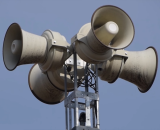
HPSS 1600
The HPSS 1600 is the budget option in the Outdoor Warning Systems series, with a lesser performance than the HPSS 3200 at a lower cost. Originally, the HPSS 1600 came in a similar form to the Federal Signal DSA, using two arrays with 8 100 W drivers. This was switched to the current DK TEC TU-300 speakers later on, with four per array, one per direction. Each horn has 4 100 W speaker drivers, for a total of 1600 W. These are driven by a single 1600 W amp, meaning HPSS 1600 units are prone to failure as if the amp fails, the entire siren is rendered completely nonfunctional. In addition, the amp lacks sufficient heatsinks leading to overheating issues. The amp also uses sine waves instead of square waves, which causes the siren to sound muddy.
Sine waves have the benefit of providing excellent voice intelligibility, however, which is one of the HPSS's main selling points. Unlike other electronic sirens, the HPSS 1600 prepares the amps and drivers before activating, which results in a very high-pitched screech from the siren just before it activates. This is apparently to prolong the life of the drivers, though this claim is dubious at best. While this is the smallest official siren in ATI's lineup, versions with only two or three speakers are also known to exist, likely as special order models. Due to the cheap manufacturing of these sirens, these failures are quite common. As a result, these sirens are infamous for their unreliability. ATI rates this siren at 121 dB at 100 ft, rivaling sirens like the ASC Tempest-121 and E-Class EC-4, Whelen WPS-2904, and the FS DSA6. However, an independent study by Georgia Tech found that the HPSS 3200 performed at 115 dB at 100 ft, meaning the HPSS 1600 performs at a much lower (and currently unknown) decibel output.
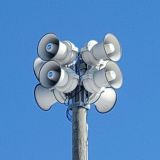
HPSS 3200
The HPSS 3200 is essentially two HPSS 1600 units in one and was introduced during the switch to the DK TEC speakers, though there are a small number of early units that used the DSA-like speakers. It has double the output of the HPSS 1600, utilizing 8 DK TEC TU-300 speakers per array, with two facing each direction. The HPSS 3200 can also be ordered in an omnidirectional configuration, with the upper row of horns facing the diagonal directions. Each horn has 4 100 W drivers, for a total of 3200 W. The HPSS 3200 is driven by two 1600 W amps, which gives more leeway if one of the amps fails, as the siren will simply function as an HPSS 1600 rather than failing entirely. In addition, the amps lack sufficient heatsinks leading to overheating issues.
The amps also use sine waves instead of square waves, which causes the siren to sound muddy. Sine waves have the benefit of providing excellent voice intelligibility, however, which is one of the HPSS's main selling points. Unlike other electronic sirens, the HPSS 3200 prepares the amps and drivers before activating, which results in a very high-pitched screech from the siren just before it activates. This is apparently to prolong the life of the drivers, though this claim is dubious at best. Due to the cheap manufacturing of these sirens, these failures are quite common. As a result, these sirens are infamous for their unreliability. This is the most popular option in the series, as well as the loudest. ATI rates this siren at 127 dB at 100 ft, rivaling the ASC E-Class EC-8 and Whelen WPS-2908. However, an independent study by Georgia Tech has found these sirens to perform closer to 115 dB at 100 ft.
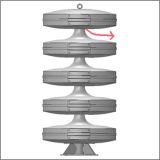
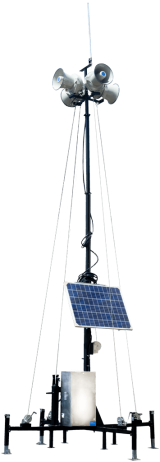
Multiple Stacked Circular Speaker Array (MSCSA)
In August 2022, ATI Systems announced the release of their next Modulator clone, the Multiple Stacked Circular Speaker Array (MSCSA). It has 8 100 W drivers per cell, with the maximum number of supported cells likely being 4. It will likely run on the same faulty controller as the other HPSS units, and very heavily resembles the Federal Signal Modulator II 4016B. While no units are known to exist in the wild yet, they can be expected to be found in the near future.
Despite having been announced in 2022, as of April of 2025, the siren is still not listed on ATI Systems' current website, and it is unknown whether or not it is for sale. Considering their previous lack of success with the OHPSS, the MSCSA may be another failure for ATI Systems.
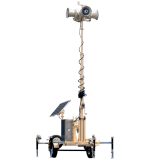
Mobile High Powered Speaker Station (MHPSS)
The MHPSS is a mobile speaker station consisting of an HPSS 1600 or HPSS 3200 speaker array placed on a foldable telescoping arm, a solar panel, the siren controller and batteries, and an independently deployable two-wheeled trailer. An extra spare tire is also included. When the siren needs to be deployed, four legs are extended onto the ground for support, and the main arm unfolds and extends to its full height with the array. The MHPSS is designed for use in areas without reliable mains power, such as in areas affected by disaster, or for public events or military installations where a permanent speaker array is unnecessary. When it is no longer needed, the arm folds neatly onto the trailer and the legs can be pulled back up so the trailer may be towed.
Transportable High Powered Speaker Station (THPSS)
The THPSS is a transportable speaker station consisting of an HPSS 1600 or HPSS 3200 speaker array placed on a foldable telescoping arm, a solar panel, the siren controller and batteries, and Unlike the MHPSS, The THPSS can be Carriable by two people instead for the tralier. When the siren needs to be deployed, four legs are extended onto the ground for support, and the main arm unfolds and extends to its full height with the array. Like the MHPSS, The THPSS is designed for use in areas without reliable mains power, such as in areas affected by disaster, or for public events or military installations where a permanent speaker array is unnecessary. When it is no longer needed, the arm folds neatly and it can be Carriable by two people allowing for unique deployment locations.
Discontinued sirens
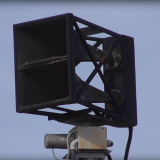
HPSS 16R
The HPSS 16R was introduced sometime before or during 2005. It is very similar in function and form to the WPS-4000 series, wiring the drivers directly to the amplifier instead of using collector rings. Because of this, the siren oscillates 360°, reversing direction when it reaches its "home" position, as well as returning to its home position upon deactivation. The siren uses TH400 speaker arrays inside of a triangular cross-braced frame, with the 400 W speaker drivers placed inside of a rear housing.
These originally used arrays with 4 throats (giving it an identical appearance to the HPSS 32R) with a single 400 W driver each, before ATI Systems figured out how to cram a second driver into each throat. This allowed them to cut the siren down to only 2 throats, with each throat outputting 800 W of sound. The 4-throat model would be later reintroduced as the HPSS 32R. Unlike other electronic sirens, the HPSS 16R prepares the amps and drivers before activating, which results in a very high-pitched screech from the siren just before it activates. This is apparently to prolong the life of the drivers. Examples of these early HPSS 16R units can be found in Menominee, WI, having replaced some early Alertronic AL-6000Rs. Their decibel rating is unknown, however those who have heard them in person claim they are similar to a Whelen Vortex-R4 when in good working order.
The rotator itself is belt-driven and placed inside a small housing under the siren. The motor sticks out of the housing, similar to Whelen's rotators. These sirens were also available without the rotator, often being installed in pairs to face certain directions when 360° was not needed. These sirens are often configured incorrectly, causing them to point in one direction and perform their tone for a minute, before rotating 90° and performing its tone again for another minute. It continues doing this until it is deactivated. This means that for three minutes at a time, 3 directions are not being warned effectively. Very few HPSS-R units are correctly configured to rotate during their tone, rendering the rotator effectively pointless. The change in direction when it oscillates is also instantaneous, with no delay. Due to very poor sales, the siren was quietly discontinued in 2018. Few are in service today.
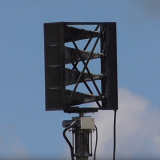
HPSS 32R
The HPSS 32R is the 3200 W version of the HPSS 16R. It uses 8 400 W drivers with 4 throats, with 2 drivers per throat. It is the result of doubling the driver count on the original 4-throat HPSS 16R. Unlike other electronic sirens, the HPSS 1600 prepares the amps and drivers before activating, which results in a very high-pitched screech from the siren just before it activates. This is apparently to prolong the life of the drivers.
The HPSS 32R is infamous for being the cause of ATI being sued for failing to meet expectations, as the siren proved disastrously unreliable when the Susquehanna Steam electric plant installed a system of these to replace a system of aging Thunderbolts. They did not perform to NRC standards and the company was sued for breach of contract. The sirens were then replaced after less than two years of service by ASC T-121s. Due to very poor sales, the siren was quietly discontinued in 2018. Few are in service today.

OHPSS
A failed product by ATI, the OHPSS was going to be ATI Systems' first attempt at creating a modular stacked-cell omnidirectional siren, similar to that of a Modulator or WPS-2900. ATI got as far as producing advertisements for the siren (using photoshopped images of a Modulator over their existing advertisements) but users on Facebook alerted Federal Signal to this, and they were quickly stopped from doing so.
Undeterred, they then attempted to buy a second-hand ASC i-FORCE unit (see the History section) in order to tear it apart and reverse engineer the design and create their own clone as a tsunami siren, but this was again thwarted when the seller realized the buyer was the daughter of ATI Systems' CEO Ray Bassiouni, and the siren was confiscated by ASC after being alerted by the seller. This particular i-FORCE unit remains at ASC's production facility today, likely as a reminder of their misdeeds. The OHPSS would be scrapped, and later redeveloped into the MSCSA.
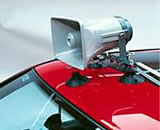
VitalSound 400
The VitalSound 400 (VS400) was a short lived electronic vehicular siren produced by ATI. The VitalSound 400 first appeared on ATI's website sometime between May of 2008 and July of 2011, and consisted of a single rectangular 400 W speaker, intended to be attached to the roof of a car via the small bracket screwed on to the sides of the horn. The VS400 and VS1600's pages were unfortunately not archived on the WayBack Machine, and as a result little to no information exists regarding these sirens apart from the brief description written on ATI's website. The VitalSound line was quietly removed from ATI's website between March of 2012 and August of 2013, and little else is known about them.
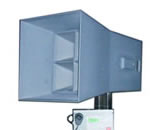
VitalSound 1600
The VitalSound 1600 (VS1600) was a short lived electronic vehicular siren produced by ATI. The VitalSound 400 first appeared sometime between May of 2008 and July of 2011, and consisted of a single large square 1600 W speaker, with 4 smaller "throats" within the horn, intended to be attached to the roof of a car via a thin steel pole mount. Some sort of control panel with a microphone attachment is visible on the image of the VS1600 provided by ATI. The VS400 and VS1600's pages were unfortunately not archived on the WayBack Machine, and as a result little to no information exists regarding these sirens apart from the brief description written on ATI's website. The VitalSound line was quietly removed from ATI's website between March of 2012 and August of 2013, and little else is known about them.